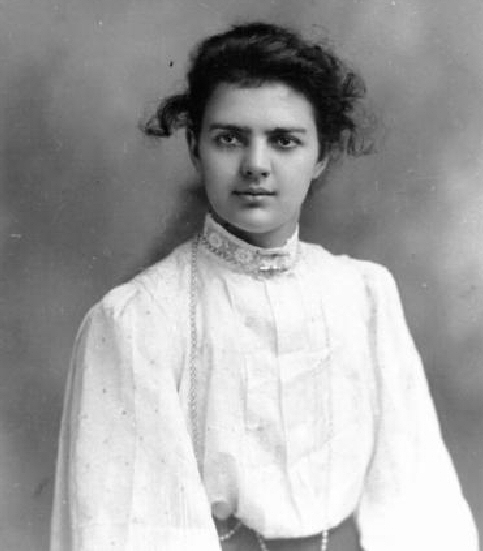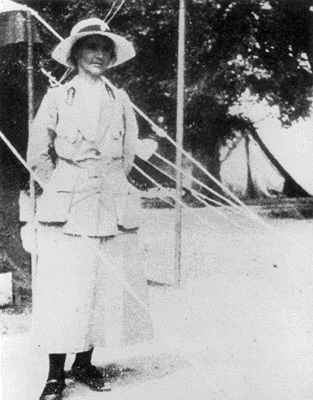| |
The Channel Islands and the Great War |
|
Dr Mary Clementina De Garis (1881-1963)
Scottish Women's Hospitals

Medal of St Sava, third class, Serbia
|
Born in 1881, Daughter of Guernsey born Elisha
Clement De Garis & Elizabeth Buncle. Died
1963 at Geelong, Australia
Dr Mary Clementina De Garis was one of the first
35 women to complete their medical degrees at
the University of Melbourne in Victoria. She graduated
M.B. (1904),B.S. (1905) and was the second woman
in the state to achieve her Doctorate of Medicine
in 1907. With her twin sister Elizabeth, she went
from Mildura to study at Methodist Ladies College
in 1898- 1899, to prepare for university entrance.
Mary excelled academically, and with her family's
encouragement, enrolled to study medicine in 1900.
Both of her parents were strong members of their
community. Their mother Elizabeth Buncle, was
known for her healing skills and her father, Elisha,
had been a Methodist minister then business entrepreneur
in real estate and dried fruit, founding E.C.
De Garis and Co. He was also an influential advocate
for irrigation. They had 8 children of whom six
survived to adulthood : Mary, Elizabeth, Clement,
Alfred, Lilian and Lucas George.
The early Melbourne medical women knew each other
and many were largely united in their feminist
mission to achieve equal rights of women focusing
particularly women's right to knowledge, control
and protection of their bodies, both for women
and girls. At university the women mentored and
tutored each other in their Princess Ida Club
and the Victorian Women Medical Students' Society.
This networking continued throughout their professional
lives with the Victorian Medical Women's Society
and the British Medical Association (later the
Australian Medical Association). Although Mary
did her Residency year at the Melbourne Hospital
- the only woman that year- she was philosophically
and politically aligned with the medical women
at the Queen Victoria Hospital. She worked there
in 1910-11 as Honorary Medical Officer to Outpatients,
then again in 1915-1916 and 1919-1922.
Adventurously, she took her first paid position
at the Muttaburra Hospital, via Rockhampton in
north Queensland from 1906 -7, as Resident Surgeon.
Restless and lonely, after 14 months, she travelled
for 14 months, sailing to the United Kingdom and
the USA completing postgraduate courses. She was
thrilled to attend the suffrage rallies and hear
the Pankhursts speak in London. Returning to the
family's new home in Sandringham, Melbourne, in
1910 she tried private practice at 24 Collins
Street; however, this failed. (It seems people
were not yet ready for women doctors). In 1911
she took up a Resident Surgeon position in Tibooburra
Hospital, western New South Wales. Here she met
Colin Thomson, a farmer, and they were engaged
one week before the outbreak of the First World
War, in 1914.
|

Mary in 1905
|
|

Mary at war in 1917
|
Believing in women's full citizenship,
she offered her medical services to the Australian
Army but was rejected - only nurses could enlist.
Colin volunteered and sailed in 1914 to Egypt,
Gallipoli then France. Wanting to be closer to
him, Mary sailed to London in 1915 and worked
at the Manor Hospital. On 4 August 1916 Colin
was killed at Pozieres. Grief stricken, Mary decided
to join the feminist Scottish Women's Hospitals
who provided female staffed and fully equipped
medical units to assist the Allies (the British
War Office refused their offer). Mary was assigned
to the 4th 'America' Unit, based in Ostrovo, Northern
Macedonia, caring for mostly Serbian wounded.
She worked with other Australian doctors - Agnes
Bennett and Lilian Cooper, nurses Saunders and
Angell and cook and orderly, Miles Franklin. Mary
was in charge of the 200 bed tent hospital for
12 months. They were away from the war front but
malaria was endemic and it snowed in winter. After
the death of her mother, she resigned in September
1918 and was awarded the medal of St Sava, third
class, by the grateful Serbian Government. En
route in Rome she contracted Spanish Influenza,
but arrived back in Melbourne in February 1919.
By May, she was in Geelong practising as the city's
first female medical practitioner, and the first
woman doctor to drive a car around Geelong.
Small with olive complexion and
white hair, in Geelong her energetic, reformist
zeal for women's health helped achieve female
members on the Hospital General Committee (1925)
and a maternity ward to be built and commissioned
(1931). That year, she became the head of the
maternity ward where she also established an antenatal
and a postnatal clinic, bringing 'Melbourne' standards
to Geelong. In 1938 the Hospital management congratulated
her on an exemplary record of 1,000 deliveries
without the loss of any mothers. Her skill and
her mother focused approach was very popular in
Geelong, especially prior to the use of antibiotics
and when infant and maternal mortality rates were
a concern.
In addition to her patients, she was conducting
research into the causes of pain in labour; she
published around 48 articles in medical journals.
She developed a new definition for labour and
did not accept that pain was a necessary part
of it; she also discussed uterine inertia, hidden
sources of infection, such as bad teeth, the effects
of diet on pregnancy and particularly toxaemia
and other complications of mothers' health. She
published three books; the most significant was
The Theory of Obstetrics (1931) which was well
received. A matron, who worked with Mary in the
1950s wrote: "Her dietary treatment of toxaemia
of pregnancy was revolutionary at the time and
became an accepted method in later years".
Her work at the Geelong Hospital was commemorated
with De Garis House named after her. She practised
well into her seventies (similar to male doctors)
although this was controversial at the time. One
of her patients described her : "She had
a mother's natural instincts herself but the whole
world was her family"
|
“Woman War Doctor: The life
of Mary de Garis”
by
Dr Ruth Lee
buy the book from here
Book
Web Site
|
| |